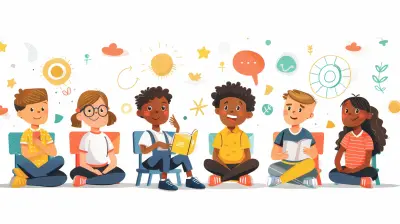Holistic Approaches to Inclusion: Addressing Social, Emotional, and Academic Needs
10 December 2024
In today's diverse educational landscape, inclusion has evolved beyond just being a buzzword. It's now a fundamental philosophy that schools and educators aim to embody, ensuring that every student, regardless of their background, abilities, or needs, feels seen, heard, and valued. But here’s the thing – inclusion isn’t just about providing access to the same classroom or curriculum. It’s about addressing the whole child – their social, emotional, and academic needs holistically.
Think of it like a puzzle. Each child is unique, a piece with their own shape and quirks. A holistic approach ensures we aren't trying to force them into a mold that doesn’t fit. Instead, we adjust the environment, the teaching strategies, and the support systems so every piece can find its place comfortably. So, how do we do that?
Let’s dive in and explore the ways holistic approaches can foster a more inclusive environment, one that nurtures every child's social, emotional, and academic development.

What Does "Holistic" Really Mean?
Before we get into the nitty-gritty, let’s clarify what we mean by "holistic." Holistic education doesn't just focus on one aspect of a student’s development. It's not just about academic success. It's about nurturing the whole child – their cognitive, emotional, social, physical, and spiritual needs.Imagine a plant. To grow, it doesn’t just need sunlight; it also requires water, good soil, and the right temperature. Similarly, children need more than just textbooks and lessons. They need emotional support, social connections, and an environment that allows them to thrive on all levels.
Now that we’ve got that out of the way, let’s look at how this applies to inclusion.

The Importance of Social Inclusion
Building Relationships and Fostering Belonging
Ever walked into a room where you didn’t know anyone? It's awkward, right? Now, imagine feeling that way every day at school. For many students, especially those with disabilities or from marginalized communities, this is their reality. Social inclusion ensures that no child is left on the sidelines, fostering a sense of belonging and connection.In a holistic approach, we don’t just focus on the academic side of things. We also look at how students interact with their peers. Are they forming meaningful friendships? Do they feel part of the community?
Strategies for Social Inclusion
1. Peer Mentoring Programs: Pairing students with mentors can help break the ice and encourage friendships. A peer mentor can introduce a student to social groups, help them navigate tricky social dynamics, and offer guidance in making connections.2. Group Activities: Collaborative projects, group discussions, and team sports are excellent ways to encourage interaction. Not only do these activities foster teamwork, but they also allow students to see the value in each other's contributions.
3. Circle Time or Morning Meetings: These are great ways to start the day on a positive note. Students can share experiences, participate in team-building activities, and feel like they’re part of a cohesive group.
Social inclusion is about making sure every child feels like they’re part of the community. But what happens when a child is struggling emotionally?

Emotional Inclusion: Addressing Emotional Well-being
The Emotional Side of Learning
We’ve all had days where we’re just not feeling it emotionally. Maybe you’re stressed, anxious, or sad. On those days, it’s hard to focus on anything, let alone schoolwork. For students, especially those with learning disabilities, trauma, or mental health challenges, emotional struggles can be a major barrier to learning.Holistic approaches recognize that students’ emotional well-being is just as crucial as their academic performance. If a child is feeling anxious, overwhelmed, or disconnected, they won’t be able to engage in learning effectively.
Creating Emotionally Supportive Environments
1. Emotional Check-ins: Teachers can incorporate daily or weekly emotional check-ins. These can be as simple as asking students to rate how they're feeling on a scale of 1-10 or using emojis to express their mood. This helps students become more aware of their emotions and opens up opportunities for teachers to provide support when needed.2. Mindfulness and Relaxation Techniques: Teaching students mindfulness or relaxation exercises can be a game-changer. Whether it's deep breathing, guided meditation, or even short breaks to stretch and move, these tools can help students manage their emotions more effectively.
3. Counseling and Emotional Support Services: Schools should have accessible mental health resources, including counselors or therapists who can provide one-on-one support. Having a dedicated space where students can go to talk about their struggles can make a world of difference.
4. Promote a Growth Mindset: Encouraging a growth mindset helps students understand that failure is a part of learning. It’s important to teach them that it’s okay to make mistakes and that they can bounce back from setbacks. This helps reduce anxiety over grades and performance.
Addressing emotional needs is key to helping students feel safe and supported in the classroom. But what about their academic needs?

Academic Inclusion: Supporting Diverse Learners
Differentiated Instruction
One size does not fit all – and that’s never been truer than in education. Students come in all shapes and sizes, with different learning styles, abilities, and needs. A holistic approach to inclusion means recognizing these differences and adjusting teaching methods to meet students where they are.Differentiated instruction is one way to do this. It’s all about providing multiple paths to learning. Some students might excel with hands-on activities, while others prefer reading or listening. By offering different ways to engage with the material, teachers can ensure that every student has an opportunity to succeed.
Strategies for Academic Inclusion
1. Universal Design for Learning (UDL): UDL is a framework that encourages flexible teaching methods to accommodate different learning styles. It suggests offering multiple means of engagement, representation, and expression. For example, a teacher might present a lesson through a combination of videos, texts, and hands-on activities, allowing students to choose the method that works best for them.2. Assistive Technology: Technology can be a powerful tool for inclusion. Tools like speech-to-text software, audiobooks, or screen readers can make learning more accessible for students with disabilities. Similarly, apps that help with organization and time management can support students with ADHD or executive functioning challenges.
3. Scaffolded Learning: Scaffolding is a technique where teachers provide temporary support to students as they learn new concepts. This might include giving them a step-by-step guide, breaking tasks into smaller parts, or providing examples. As students become more confident, the support is gradually removed, allowing them to take on more responsibility.
Collaborative Learning
In an inclusive classroom, learning isn’t a solitary activity. Collaborative learning encourages students to work together, share ideas, and learn from one another. This not only promotes academic growth but also fosters social and emotional skills.Group projects, peer editing, and classroom discussions are all ways to encourage collaboration. When students work together, they learn to appreciate different perspectives, develop problem-solving skills, and build a sense of community.
The Role of Teachers and Schools in Holistic Inclusion
Professional Development for Educators
Teachers are at the heart of inclusive education. But let’s be real – it’s not easy to juggle the diverse needs of 20 or 30 students. This is where professional development comes in. Schools need to invest in training educators on how to implement holistic, inclusive practices. This might include workshops on differentiated instruction, emotional intelligence, or trauma-informed teaching.Creating an Inclusive School Culture
Inclusion isn’t just about what happens in the classroom. It’s about creating a school-wide culture where diversity is celebrated, and every student feels valued. This starts with the leadership – school administrators and principals need to model inclusive practices and ensure that policies reflect the school’s commitment to inclusion.It also means involving parents and the wider community. When families are engaged and feel part of the process, students are more likely to thrive.
Conclusion: A Holistic Approach Is Key to True Inclusion
At the end of the day, inclusion is about more than just making sure every student has a seat in the classroom. It’s about ensuring that every child feels valued, supported, and understood – socially, emotionally, and academically. A holistic approach means considering the whole child and providing the tools, strategies, and environment they need to succeed.By addressing students’ social, emotional, and academic needs, we can create a truly inclusive environment where every child has the opportunity to shine. And isn’t that what education is all about?
all images in this post were generated using AI tools
Category:
Inclusive EducationAuthor:

Fiona McFarlin
Discussion
rate this article
18 comments
Faenor Daniels
This article brilliantly highlights the importance of holistic approaches in education. By integrating social, emotional, and academic support, we can create inclusive environments that foster well-rounded development, ensuring every learner thrives and feels valued in their educational journey.
February 6, 2025 at 8:40 PM

Fiona McFarlin
Thank you for your insightful comment! I completely agree that integrating these approaches is essential for nurturing inclusive and supportive educational environments.
Lark McKee
Oh great, another article on inclusion! Because who doesn’t love the idea of juggling social, emotional, and academic needs like a circus performer on a unicycle?
January 31, 2025 at 12:31 PM

Fiona McFarlin
I appreciate your perspective! Balancing these needs can indeed be challenging, but a holistic approach aims to make it more manageable and effective for everyone involved.
Eleanor Thornton
All needs covered, like a buffet!
January 25, 2025 at 3:49 AM

Fiona McFarlin
Thank you! Just like a buffet, a holistic approach ensures everyone's needs are met for a balanced, fulfilling experience.
Runeveil McKinstry
Embracing holistic approaches to inclusion is like crafting the perfect smoothie! Blend together social, emotional, and academic needs for a deliciously supportive learning experience. Let’s stir up compassion, sprinkle in understanding, and sip on the joys of a thriving, inclusive classroom! Cheers to every learner!
January 21, 2025 at 12:38 PM

Fiona McFarlin
Thank you for this creative analogy! Emphasizing the blend of social, emotional, and academic needs is key to fostering an inclusive learning environment. Cheers to nurturing every learner’s potential!
Elle Reese
This article beautifully highlights the importance of a holistic approach to inclusion in education. By addressing social, emotional, and academic needs, we can create a more equitable learning environment that fosters growth and belonging for all students.
January 17, 2025 at 5:45 AM

Fiona McFarlin
Thank you for your thoughtful comment! I'm glad you see the value in a holistic approach to inclusion—it truly is essential for fostering growth and belonging in our educational environments.
Vaughn Tucker
Holistic inclusion enriches education by recognizing the interconnectedness of social, emotional, and academic needs, fostering truly supportive learning environments for all.
January 14, 2025 at 7:57 PM

Fiona McFarlin
Thank you for highlighting the importance of holistic inclusion! Recognizing the interconnectedness of diverse needs truly enhances the educational experience for everyone involved.
Leah McCool
This article beautifully highlights how addressing the whole child fosters true inclusion. It’s inspiring to see education evolving to meet diverse needs!
January 8, 2025 at 4:54 AM

Fiona McFarlin
Thank you for your thoughtful comment! I'm glad you found the article inspiring and that it resonates with the importance of holistic approaches in education.
Lyra Benson
This article provides valuable insights into the importance of addressing the interconnectedness of social, emotional, and academic needs in education. Embracing holistic approaches can significantly enhance inclusivity and support for all students. Thank you for shedding light on this crucial aspect of modern educational practices!
January 4, 2025 at 5:46 AM

Fiona McFarlin
Thank you for your thoughtful comment! I'm glad you found the insights valuable. Emphasizing holistic approaches is indeed essential for fostering inclusivity and supporting every student's well-being.
Xena Kelly
This article beautifully captures the essence of holistic inclusion. By addressing social, emotional, and academic needs, we create an environment where every student can thrive. Your insights inspire educators to embrace comprehensive strategies that foster belonging and support the whole child. Thank you for sharing!
January 1, 2025 at 1:59 PM

Fiona McFarlin
Thank you for your kind words! I'm glad the article resonated with you and highlights the importance of supporting the whole child in education.
Liam Tucker
Because who doesn't love a sprinkle of unicorn magic with their math lessons? Let's embrace the whole child, inside and out!" 🦄✨
December 28, 2024 at 1:50 PM

Fiona McFarlin
Absolutely! Embracing creativity and joy in education enhances both emotional and academic growth, making learning truly magical. 🦄✨
Seth McCaffrey
Thank you for this insightful article! Your exploration of holistic approaches to inclusion truly highlights the interconnectedness of social, emotional, and academic needs. By addressing these areas collectively, we can foster a more supportive learning environment for all students. I look forward to further discussions on this important topic!
December 25, 2024 at 11:51 AM

Fiona McFarlin
Thank you for your thoughtful comment! I'm glad you found the article insightful, and I appreciate your interest in further discussions on this vital topic.
Zacharias Patterson
Embracing holistic approaches in education is essential. Addressing social, emotional, and academic needs creates a thriving environment where all students can succeed and flourish.
December 14, 2024 at 8:26 PM

Fiona McFarlin
Thank you for your insightful comment! I completely agree that a holistic approach is vital for fostering an inclusive educational environment that supports the diverse needs of all students.
Giovanna Ruiz
Think of inclusive education like a colorful pizza—each topping represents a unique need! 🍕 When we blend social, emotional, and academic ingredients, we create a deliciously harmonious slice of learning that satisfies every curious mind. Let’s dig into it!
December 12, 2024 at 3:53 AM

Fiona McFarlin
Absolutely! Just like a colorful pizza, inclusive education beautifully combines diverse needs, ensuring every learner thrives in a supportive environment. Let's celebrate this delicious approach! 🍕
Merida McClintock
Who knew inclusion could be a three-course meal? Serving up social, emotional, and academic needs with a side of laughter—because every learner deserves to feast on knowledge and joy. Bon appétit!
December 11, 2024 at 1:26 PM

Fiona McFarlin
Thank you! I'm glad you enjoyed the metaphor. Holistic inclusion truly nourishes the whole learner!
Meredith McIntyre
Inclusion isn't optional; it's a necessity. Embracing holistic approaches means recognizing the interconnectedness of social, emotional, and academic needs. Let's stop making excuses and start transforming our educational practices for every learner.
December 11, 2024 at 3:53 AM

Fiona McFarlin
Thank you for your insightful comment! I wholeheartedly agree that true inclusion requires a commitment to holistic practices that support all aspects of a learner's development. Let's work together to drive meaningful change in education.
Natalia Strickland
This article provides valuable insights into holistic approaches to inclusion, emphasizing the interconnectedness of social, emotional, and academic needs. By fostering an inclusive environment that addresses these dimensions, educators can better support diverse learners. It's essential to continue exploring effective strategies that promote overall student well-being and success.
December 10, 2024 at 9:11 PM

Fiona McFarlin
Thank you for your thoughtful comment! I'm glad you found the article valuable in highlighting the importance of a holistic approach to inclusion. Supporting diverse learners through interconnected strategies is indeed essential for their overall success.
Ariana Snyder
Great insights on fostering inclusivity! Addressing social, emotional, and academic needs is crucial for student success. Excited to see how these holistic approaches can transform our educational landscape!
December 10, 2024 at 12:17 PM

Fiona McFarlin
Thank you! I'm glad you found the insights valuable. Emphasizing holistic approaches is key to creating an inclusive educational environment that supports all students.
Miles Luna
Great insights on holistic inclusion! It's crucial to recognize the interconnectedness of social, emotional, and academic needs. Implementing these approaches can foster a more supportive learning environment for all students.
December 10, 2024 at 3:56 AM

Fiona McFarlin
Thank you! I'm glad you found the insights valuable. Recognizing the interconnectedness of these needs is essential for creating an inclusive learning environment.
MORE POSTS

Networking Opportunities You Can't Miss as an Exchange Student

How to Stay Connected with Your Host Country After Your Exchange Program Ends

Using Field Trips to Enrich Your Homeschool Curriculum

Teaching Civic Education in a Multicultural Society

How Civic Education Encourages Lifelong Learning and Civic Engagement

Exploring History Through Homeschooling: Engaging Ideas

How Teachers Can Cultivate a Creative Classroom Environment

Cultural Diffusion: How Ideas Cross Borders

How to Create a Fair Grading Rubric for Group Projects

Understanding Light Refraction with DIY Rainbow Experiments

How to Foster Collaboration Between Special and General Education Teachers